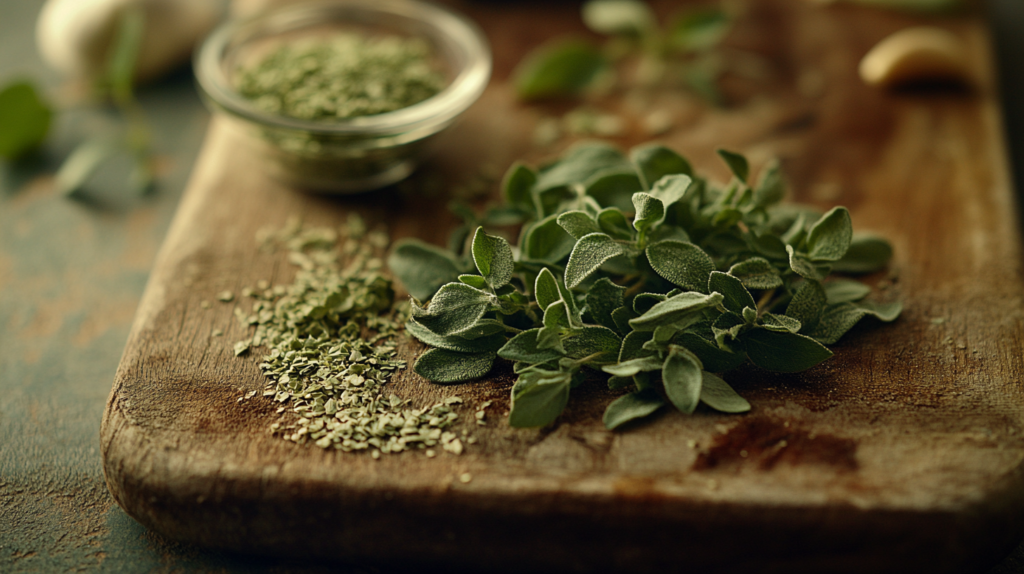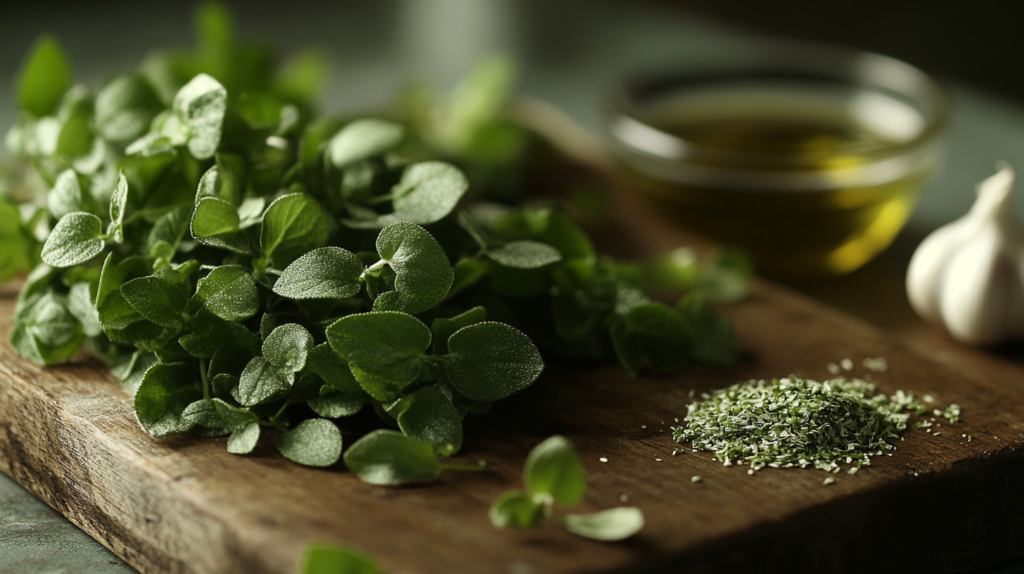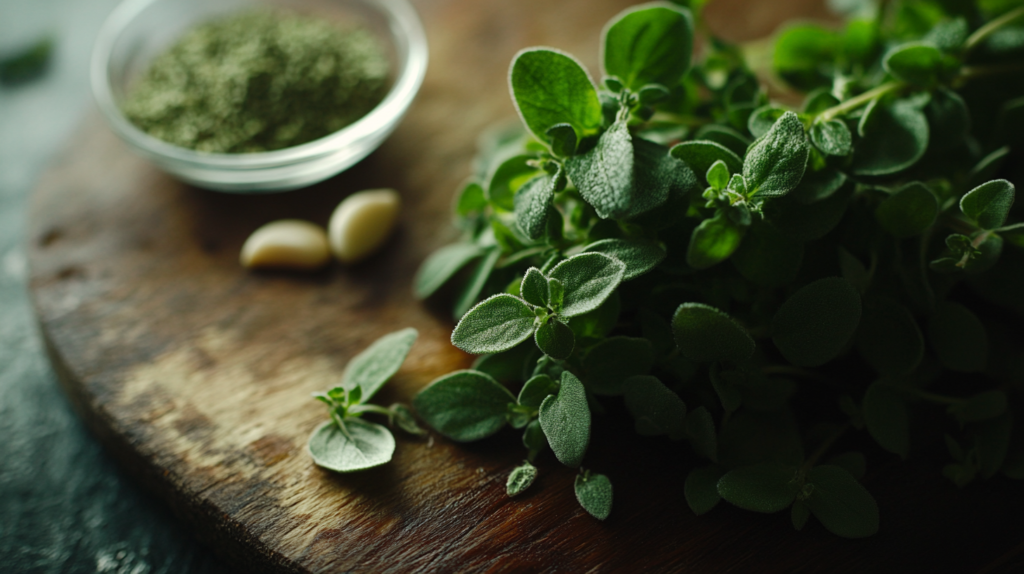What is Marjoram?
Marjoram is a fragrant herb belonging to the mint family (Lamiaceae), prized for its delicate, sweet, and slightly floral flavor. Often used in Mediterranean, Middle Eastern, and European cuisines, marjoram adds a subtle complexity to dishes like soups, stews, sauces, and marinades. Its soft, velvety leaves and warm aroma make it a staple in many kitchens, especially for seasoning poultry, vegetables, and stuffing.
Difference Between Marjoram and Oregano
Though marjoram and oregano belong to the same plant family and share similarities, they have distinct flavors and uses:
- Flavor Profile:
- Marjoram: Delicate, sweet, and floral with a milder taste.
- Oregano: Robust, earthy, and peppery with a more intense flavor.
- Culinary Use:
- Marjoram is often used in lighter dishes, like salads, chicken, or seafood, where its subtle flavor can shine.
- Oregano is more common in hearty dishes, like pizza, pasta sauces, and grilled meats, due to its bolder taste.
- Appearance:
- Marjoram leaves are smaller, lighter in color, and softer to the touch.
- Oregano leaves are darker and more textured.
Historical Background and Origin of marjoraam
Marjoram has a rich history dating back to ancient civilizations:
- Ancient Greece and Rome: The Greeks and Romans revered marjoraam as a symbol of happiness and prosperity. They used it in cooking, medicine, and even as a fragrance in perfumes and oils.
- Egyptian Use: Ancient Egyptians utilized marjoraam for medicinal purposes, believing it could heal ailments and improve digestion.
- Mediterranean Origins: Native to the Mediterranean region, marjoraam thrives in warm climates and became a staple in regional cuisines. It spread to other parts of the world through trade and exploration.
Marjoram’s delicate flavor, versatility, and historical significance make it a timeless herb cherished by cooks and herbalists alike. Whether used fresh or dried, marjoraam continues to elevate dishes with its subtle yet distinctive aroma.
The History of marjoraam
marjoraam, a fragrant herb from the mint family, has a long and fascinating history intertwined with ancient civilizations, cultural traditions, and medicinal practices. Its journey from a Mediterranean native to a globally cherished herb reveals its enduring appeal and versatility.

Origin of marjoraam in Ancient Civilizations
marjoraam is believed to have originated in the Mediterranean region, where it thrived in warm, sunny climates. Ancient Egyptians, Greeks, and Romans were among the first to cultivate and use marjoram for its culinary, medicinal, and aromatic properties.
- Egyptians: The Egyptians valued marjoraam for its medicinal benefits, using it in healing balms and rituals. They also associated the herb with health and protection.
- Greeks and Romans: In ancient Greece and Rome, marjoram symbolized joy and happiness. It was used to flavor food and create fragrant oils, while wreaths of marjoraam adorned newlyweds as a blessing for a happy marriage.
Cultural Significance in the Mediterranean Region
Marjoram’s association with prosperity and well-being made it a prominent herb in Mediterranean culture. Its mild and floral flavor became a key ingredient in regional cuisines, especially in Greek, Italian, and Middle Eastern dishes.
- Culinary Use: marjoraam was widely used in sauces, soups, and meat dishes, complementing the bold flavors of Mediterranean cooking.
- Spiritual Practices: Many Mediterranean communities believed marjoram to have protective qualities, using it in rituals and home gardens to ward off negative energy.
marjoraam in Folklore and Traditional Medicine
Throughout history, marjoram has been celebrated not only for its flavor but also for its supposed healing properties and presence in folklore.
- Traditional Medicine: Ancient herbalists prescribed marjoram to alleviate digestive issues, colds, and muscle pain. It was also used as a soothing tea for stress relief.
- Folklore: In European folklore, marjoram was considered a magical herb capable of strengthening love and fostering happiness. It was often included in charm bags and potpourri for its pleasing scent and symbolic value.
Marjoram’s historical significance goes beyond its culinary uses, highlighting its role as a symbol of joy, health, and prosperity. Its deep roots in ancient traditions and continued popularity make it a timeless herb that bridges the past and present.
Caring for marjoraam Plants
Marjoram is a hardy herb that thrives with proper care, rewarding gardeners with its fragrant leaves and delicate flavor. Below are tips for pruning, harvesting, and addressing common pests to keep your marjoram plants healthy and productive.
Pruning and Harvesting Tips
- Regular Pruning:
- Trim the plant regularly to encourage bushier growth and prevent it from becoming woody.
- Use sharp scissors or pruning shears to cut back stems, avoiding damage to the plant.
- Remove any flowers as they appear, as flowering can reduce the flavor of the leaves.
- Harvesting Marjoram:
- Harvest leaves in the morning after the dew has dried, as this is when the oils are most concentrated.
- Pick individual leaves or cut entire stems about 2–3 inches from the base.
- Regular harvesting not only provides fresh marjoram but also stimulates new growth.
- Drying and Storing:
- If you have a surplus, dry marjoram by hanging bunches upside down in a cool, dark place. Once dry, crumble the leaves and store them in an airtight container.
Common Pests and How to Address Them
- Aphids:
- Small, soft-bodied insects that suck sap from the leaves, causing them to curl and yellow.
- Solution: Spray the plant with a mixture of water and mild soap or use a natural insecticidal spray.
- Spider Mites:
- Tiny pests that create webbing on the underside of leaves and cause speckled discoloration.
- Solution: Rinse the plant with water to dislodge the mites or apply neem oil as a natural repellent.
- Whiteflies:
- Small, white-winged insects that feed on plant sap and weaken the plant.
- Solution: Use yellow sticky traps to capture adult whiteflies and spray the plant with insecticidal soap.
- Fungal Diseases:
- Overwatering or poor air circulation can lead to fungal issues like powdery mildew.
- Solution: Ensure proper spacing between plants, water at the base, and remove any affected leaves promptly.
By pruning and harvesting regularly and addressing pests promptly, you can maintain a healthy marjoram plant that continues to provide fragrant, flavorful leaves for your cooking and enjoyment.
Propagating marjoraam
Marjoram is an easy-to-propagate herb, whether you’re starting from seeds or cuttings. With proper techniques, you can grow healthy marjoraam plants that thrive in your garden or indoors. Below are methods and best practices for successful propagation.
Growing Marjoram from Seeds
- Seed Selection and Preparation:
- Use high-quality marjoram seeds for the best germination results.
- Soak the seeds in warm water for a few hours to soften the seed coat and encourage sprouting.
- Planting Seeds:
- Fill seed trays or pots with well-draining soil or a seed-starting mix.
- Scatter the seeds lightly on the soil surface and cover them with a thin layer of soil (about 1/8 inch).
- Water gently to keep the soil moist but not waterlogged.
- Optimal Growing Conditions:
- Place the pots in a warm location with bright, indirect sunlight.
- Maintain a temperature of 65–70°F (18–21°C) for best results.
- Expect germination in 10–14 days. Once the seedlings have 3–4 true leaves, transplant them into larger pots or your garden.
Growing Marjoram from Cuttings
- Choosing Cuttings:
- Select healthy, non-flowering stems from an established marjoram plant.
- Cut 4–6-inch sections just below a leaf node using clean, sharp scissors.
- Preparing the Cuttings:
- Remove the leaves from the bottom 2 inches of the stem, leaving the top leaves intact.
- Optionally, dip the cut end in rooting hormone to encourage faster root development.
- Planting the Cuttings:
- Place the cuttings in a pot filled with moist, well-draining potting soil.
- Insert the stem into the soil about 2 inches deep, ensuring it stays upright.
- Water gently and cover the pot with a plastic bag to create a mini-greenhouse effect, maintaining humidity.
- Care for Rooting Success:
- Place the pot in a warm location with indirect sunlight.
- Check the soil regularly to ensure it stays moist but not soggy.
- Roots typically develop in 2–3 weeks. Once the cuttings have established roots, transplant them into larger containers or your garden.
Best Practices for Propagation Success
- Soil Quality:
- Use a light, well-draining soil mix to prevent root rot and support healthy growth.
- Watering:
- Keep the soil consistently moist during the germination or rooting phase but avoid overwatering.
- Lighting:
- Provide bright, indirect sunlight for seedlings and cuttings. If growing indoors, consider using a grow light for consistent illumination.
- Timing:
- For outdoor planting, start seeds or cuttings indoors 6–8 weeks before the last frost, then transplant when the weather warms.
With these propagation methods and tips, you can successfully grow marjoram from seeds or cuttings, ensuring a steady supply of this aromatic herb for your garden and kitchen.
FAQs About Marjoram
Here are answers to some common questions about marjoram, covering its uses, benefits, and cultivation tips.
1. What are the culinary uses of marjoram?
Marjoram is a versatile herb used to enhance the flavor of soups, stews, sauces, salads, and marinades. It pairs well with poultry, fish, vegetables, and even breads, adding a sweet and floral note to dishes.
2. How is marjoram different from oregano?
While both belong to the mint family, marjoram has a milder, sweeter, and more floral flavor compared to oregano’s bold, peppery taste. Marjoram is often used in delicate dishes, while oregano suits robust, hearty recipes like pizza and pasta sauces.
3. Does marjoram have health benefits?
Yes, marjoram is known for its potential health benefits. It may aid digestion, reduce inflammation, and promote relaxation. Additionally, it contains antioxidants and compounds that support overall wellness.
4. Can I grow marjoram indoors?
Absolutely! Marjoram thrives indoors when provided with sufficient light. Place it near a sunny window, water it moderately, and ensure good drainage. Indoor marjoram can provide fresh leaves year-round.
5. What conditions are best for growing marjoram outdoors?
Marjoram grows well in warm, sunny climates with well-drained soil. It prefers temperatures between 65–75°F (18–24°C) and should be watered sparingly to prevent root rot.
6. How do I harvest and store marjoram?
Harvest marjoram by cutting the stems just above a leaf node. Use fresh leaves immediately or dry them by hanging the stems in a cool, dark place. Once dried, store the leaves in an airtight container.
7. Can I substitute marjoram for oregano in recipes?
Yes, marjoram can substitute for oregano in recipes, especially if a milder flavor is desired. However, you may need to adjust the quantity since marjoram’s taste is subtler.

8. What pests affect marjoram plants?
Common pests include aphids, spider mites, and whiteflies. Combat them with natural insecticidal sprays or by introducing beneficial insects like ladybugs to your garden.
Pair Marjoram with Bold Flavors
Enhance marjoram’s delicate flavor by incorporating it into dishes like this creamy garlic parmesan sauce for a balanced, aromatic result.
Explore Mediterranean Dishes
Discover how marjoram complements Mediterranean classics, like the vibrant Mediterranean quinoa power bowl packed with fresh herbs and flavors.
Blend with Spices
Use marjoram alongside other herbs in hearty comfort dishes like this flavorful lasagna soup recipe.
Perfect for Stuffed Dishes
Marjoram adds depth to recipes like these roasted stuffed bell peppers, creating a well-rounded and aromatic filling.
Incorporate into Chicken Recipes
Bring out the best in poultry by seasoning with marjoram in recipes like this chicken tenderloin recipe for a flavorful meal.
Use in Classic Comfort Foods
Infuse your casseroles or baked dishes with marjoram, inspired by this hashbrown casserole recipe.
Experiment with Vegetarian Options
Add marjoram to vegetarian creations like this dense bean salad for an herbaceous twist.
Conclusion: Marjoram’s Enduring Appeal
Marjoram is much more than a simple herb; it’s a cornerstone of culinary, medicinal, and cultural traditions. Its versatility shines in the kitchen, where its sweet and floral notes elevate a wide variety of dishes, from soups and sauces to meats and vegetarian creations. Beyond cooking, marjoram has long been valued for its potential health benefits, including aiding digestion, reducing inflammation, and promoting relaxation.
Culturally, marjoram has been revered throughout history, symbolizing happiness and prosperity in ancient civilizations. Its enduring appeal is a testament to its adaptability and significance across the Mediterranean and beyond.
Whether you’re cultivating it in your garden, adding it to a favorite recipe, or exploring its therapeutic uses, marjoram remains a timeless and indispensable herb, cherished by gardeners, cooks, and herbalists alike. Its delicate flavor, aromatic properties, and rich heritage ensure it will continue to play a vital role in both kitchens and traditions worldwide.



